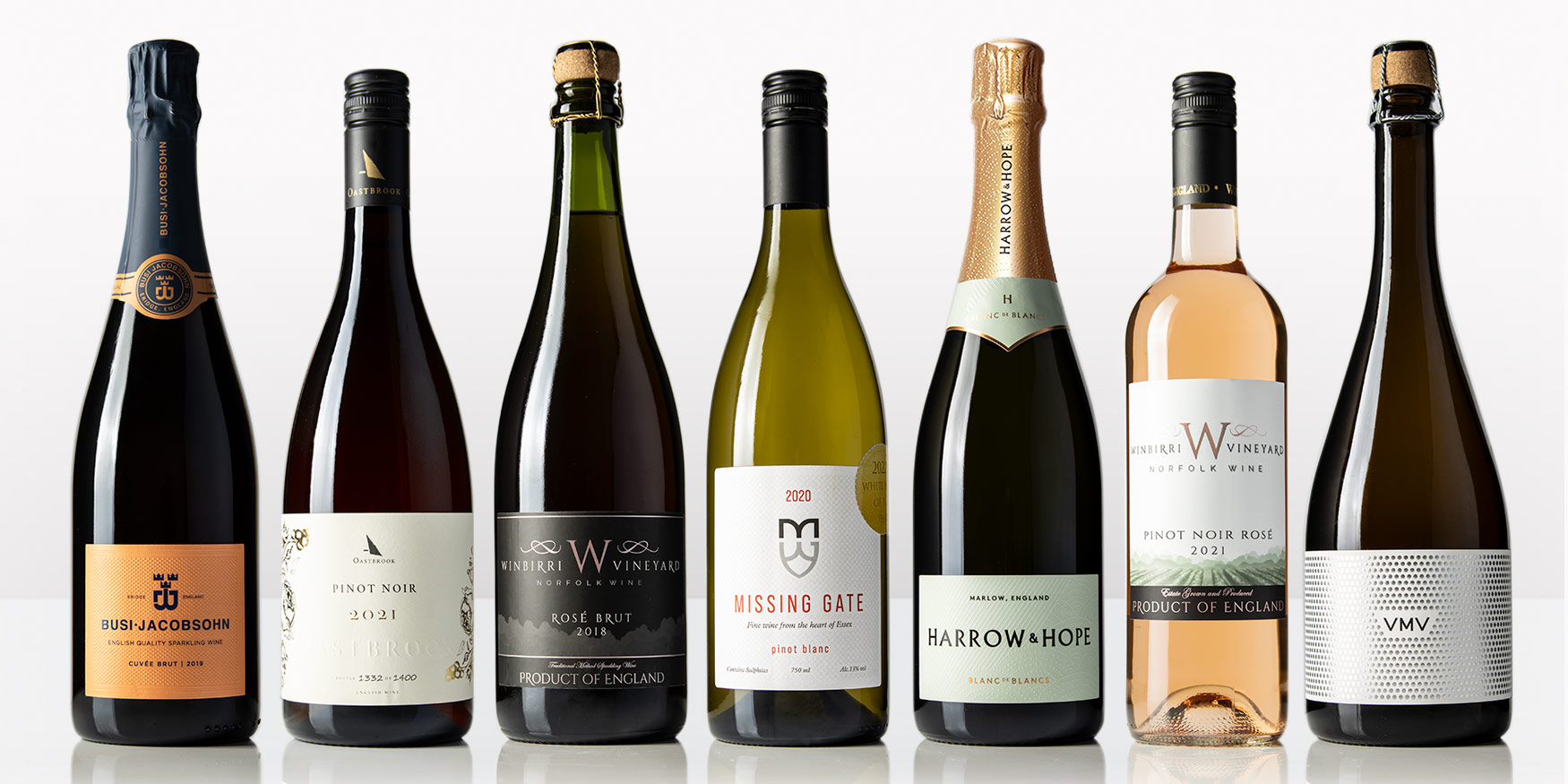
It’s been another slow start to the year for me, with work and family commitments taking my focus away from wine. However, over the last couple of months I’ve tasted some outstanding English wines once again.
Wine of the month for February comes once again courtesy of Essex, and the delectable Missing Gate Pinot Blanc 2020 (£35.00). It’s by far the best example of Pinot Blanc I’ve tasted from England, and such a wonderful, textural wine in its own right. Keeping things on the still side, Oastbrook’s youthful Pinot Noir 2021 (£32.00) shows that you can still deliver a bold, vibrant Pinot even in cooler years in England. Meanwhile, the latest vintage of the ever-reliable Winbirri Rosé Pinot Noir arrives just in time for a bit of spring sunshine.
On the sparkling side, the four wines included couldn’t be more diverse. First up is the fresh and exhilarating Busi-Jacobsohn Cuvée Brut £38.00, and the indulgent and ripe Harrow and Hope Blanc de Blancs 2018. Then, on the more distinctive side is Winbirri’s first sparkling rosé wine, the Rosé Brut 2018, which is made entirely from the Dornfelder grape. Expect generous ripe summer berry flavours and vivid colour. Finally, I end on Flint’s VMV ‘Venn Multi Vintage’ (£49.99) which, in its blend of three simultaneous vintages, delivers distinctive and rare sparkling expression from winemaker, Ben Witchell.
Missing Gate Pinot Blanc 2020
• WINE OF THE MONTH •
Grapes: Pinot Blanc
Region: Essex
Missing Gate vineyard, based in Chelmsford, Essex, has slipped under the radar a little as it emerged on the scene, but this Pinot Blanc 2020 has put them firmly on the radar, with Tom Hewson declaring it White Wine of the Year in his England 2022 report. It certainly doesn’t disappoint and is another excellent and structured English wine from Ben Smith of Itasca. He’s a name we are going to be talking about more and more this year.
The nose is bright and perfumed, a fusion of flinty, smoky minerality with fragrant citrus zests, piquant tropical bursts and waves of peach.
The palate further pleases, beginning with racy acidity, tangy lemon and lime freshness, and bursts of tingling minerality. It’s got a freshness akin to an invigorating volcanic white wine. But the real surprises are the softer, creamier waves of peach and light buttery notes that really elevate this.
Oastbrook Pinot Noir 2021
Grapes: Pinot Noir
Region: Sussex
This is the second vintage of Pinot Noir from Oastbrook, boasting a richer, fuller style with thanks to a small but late harvest. The Pinot was aged in new oak for two months and then in two-year-old oak for a further ten months.
The wine’s pleasing ruby hue is echoed by a colourful nose of red cherry, raspberry and cedarwood spice, with black pepper and roasted spices.
Whilst the oak is pronounced and probably needs a little longer to really integrate, what shines is the brightness of the tangy red fruit flavours. Overall, this is really well-structured with a brisk acidity, light tannin texture, and a peppery, spicy finish.
Winbirri Pinot Noir Rosé 2021
Grapes: Pinot Noir
Region: Norfolk
I’ve long said that still English Rosé is England’s secret weapon in the wine world, producing delightfully concentrated red fruit that delights with racy freshness and clean acidity. Winbirri’s Pinot Noir Rosé is a classic example of this, the 2018 vintage having picked up GBW Wine of the Month back in Feb 2020. This 2021 vintage is another stellar one.
This Pinot Noir was whole bunch pressed using a champagne cycle to minimise oxidation and preserve fruit freshness. And fresh it is, with a nose of raspberry, cherry and zesty pink grapefruit and lemon.
The wine bursts onto the tastebuds immediately with its tangy raspberry, cherry and cranberry flavours, and that promised citrus invigoration. What makes this stand out, as with precious vintages, is the softer, riper cherry and strawberry mid-taste with a slight creaminess that adds weight and indulgence – brilliant.
Busi-Jacobsohn Cuvée Brut 2019
Grapes: Chardonnay, Pinot Noir & Pinot Meunier
Region: Sussex
Three vintages in, and Busi-Jacobsohn really feels like they are starting to enter their stride. Take this 2019 Brut – it’s a blend of 60% Chardonnay, 20% Pinot Noir and 20% Pinot Meunier, and it spent two years on the lees prior to release with once again a low dosage of 4.3g/l.
The wine opens with vivacious bubbles, a suitably fragrant nose of ripe orchard fruit, a lively lemon note, and a mixture of mineral and roasted oat complexity.
Its flavour profile is most appealing, combining the expected zesty citrus and crisp orchard fruit, whilst the mid-taste teases with white peach and softer pastry hues. Again, the suggestions of nutty complexities, honeyed almonds and rolled oats, really lift this – thoroughly enjoyable.
Harrow & Hope Blanc de Blancs 2018
Grapes: Chardonnay
Region: Buckinghamshire
Harrow and Hope have been a beacon of quality English Sparkling Wine to me ever since I started Great British Wine, and they just seem to go from strength to strength. Henry Laithwaite’s Blanc de Blancs 2018 is one of his most engaging wines to date, with 34 months on the lees, 50% barrel fermentation and 6.2g/l residual sugar.
The nose is rich and vibrant, combining fresh and baked apples, honeysuckle, peach and pastry complexities.
The palate delivers on the nose’s promise, with rich, ripe orchard and stone fruit generosity. A softness and opulent creaminess makes this incredibly satisfying but the linear citrus and mineral backbone, together with the lively acidity, adds perfect balance and adds tension. A true delight.
Winbirri Rosé Brut 2018
Grapes: Dornfelder
Region: Norfolk
Believe it or not, this is the long-established and multi-award-winning Norfolk producer’s first take on a sparkling rosé. What makes it even more unusual is that it’s made from Dornfelder, a dark-skinned red grape of Germanic origin that Winbirri also use rather successfully to make an English red.
On pouring, the wine’s vibrant magenta and red colours live up to the winery’s promise of sunset hues. The nose stands out too, with aromas of strawberry and raspberry as well as grapefruit and cherry.
The palate is soft and fruity, showing generous red berry richness, with hints of rhubarb, cherry and pear drops on the finish.
This is another example of a producer working with non-classic sparkling varieties and delivering something really enticing and distinctive.
Flint Venn Multi Vintage ‘VMV’
Grapes: Pinot Noir, Chardonnay & Pinot Meunier
Region: Norfolk
‘VMV’, or Venn Multi Vintage, has been in planning since the year of first production at Flint in 2016. It’s a blend of the best juice across three vintages, with 2016 and 2017 being aged in neutral Burgundian oak and 2018 staying in tank. All wines went through Malolactic Fermentation, and the final blend was bottled in 2019 before being disgorged this year. Interestingly, Ben is holding back half of the wine on the lees for a further two years so that customers can taste side by side in the future and see the development of the wine both on the lees and under cork.
The nose on the VNV is really quite distinctive, with aromas of red apples, golden plums and lemon zest, as well as a pronounced floral note of jasmine or orange blossom. I also picked up the influence of oak – a lightly spiced and almost herbaceous quality that I often pick up on Ben’s wines – particularly his Silex Blanc.
To taste, this wine has a real sense of purity and freshness. There’s quite a racy burst of citrus and almost tropical fruit up front. It’s more yuzu than lemon, with a hint of something slightly exotic that I couldn’t quite place. It’s a brisk, lean expression thanks to the low dosage of 5g/l, but that’s countered nicely by the concentration of the fruit and the slight warmth of oak running in the background.
Although it’s spent three years on the lees, I did not pick up on too much autolytic influence. There’s perhaps a slight hint of baked bread in there, but this wine is really all about that fruit purity.
Overall, the VMV is really quite unlike anything else I’ve tasted for quite some time and it will be fascinating to see how it evolves.


